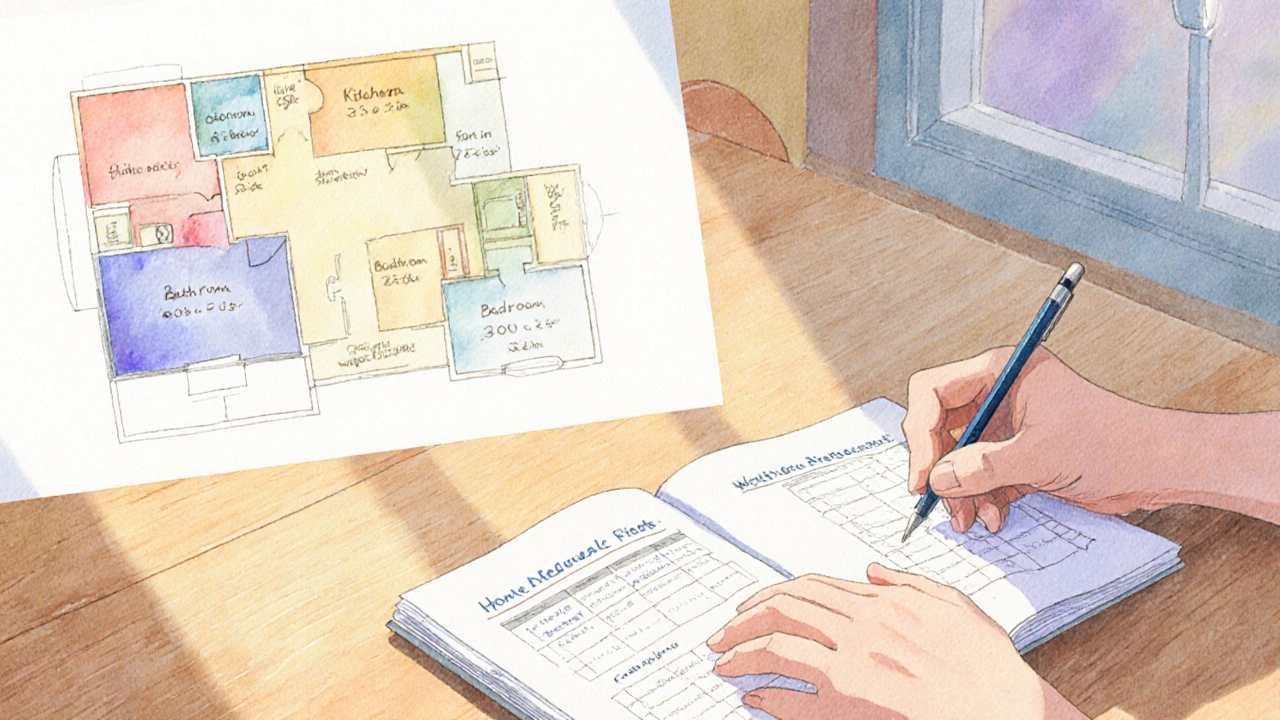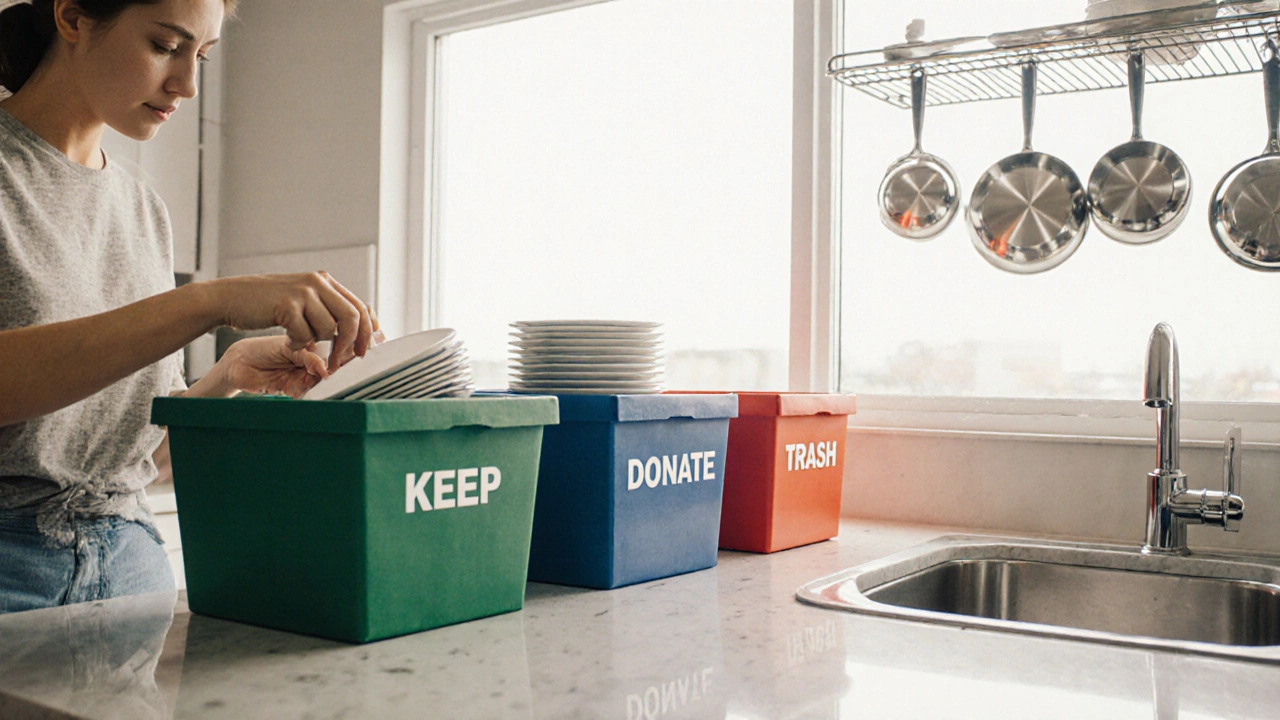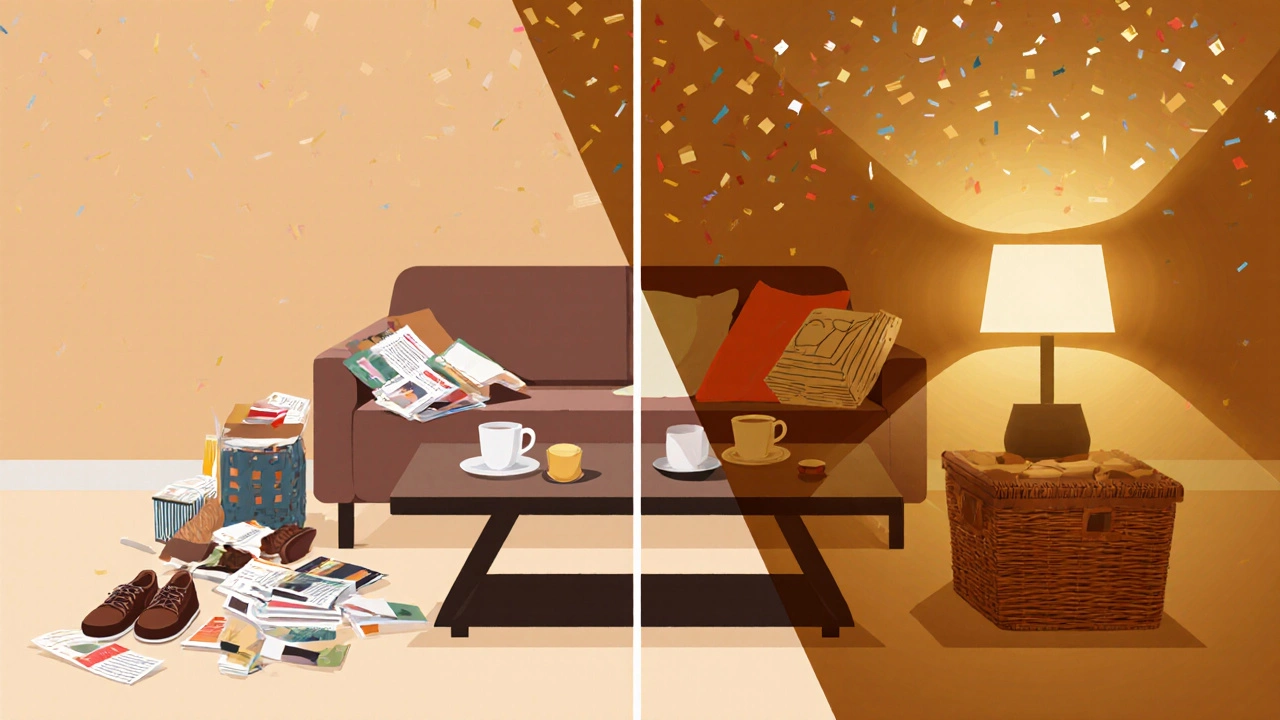How to Choose Which Room to Declutter First

Staring at piles of clothes, dishes, or random junk can feel like a full‑time job. The good news? You don’t have to tackle the whole house at once. Picking the right room to start with can give you a confidence boost, free up daily‑use space, and set a rhythm for the rest of the project.
Key Takeaways
- Start where the clutter impacts your routine most - usually the kitchen or bathroom.
- Measure "quick‑win" potential: smaller rooms with obvious trash tend to show results fast.
- Use a simple scoring system (clutter level, daily use, emotional load) to rank rooms.
- Follow a step‑by‑step plan: clear, sort, store, and celebrate.
- Avoid common traps like trying to keep everything "just in case" or moving mess from one spot to another.
Below is a practical roadmap that lets you answer the question declutter first without endless guessing.
Why the first room matters
When you finish a room, the visible improvement fuels motivation. Psychologists call this the "progress principle" - small wins boost morale and keep you moving. Conversely, starting with a room that feels overwhelming can stall the whole effort.
Decision criteria: scoring each room
Grab a notebook or a notes app and rate every room on three simple factors. Use a scale of 1 (low) to 5 (high). Add the numbers - the highest total points to your starter room.
- Clutter Level - how much stuff is piled up? Think visible mess, stacked boxes, and loose items.
- Daily Use Impact - how often do you need the room? Kitchens and bathrooms score high because you visit them several times a day.
- Emotional Load - does the space hold sentimental items that make decision‑making harder? Bedrooms often carry emotional weight.
Example scoring table (you’ll customize it for your home):
| Room | Clutter Level (1‑5) | Daily Use (1‑5) | Emotional Load (1‑5) | Total |
|---|---|---|---|---|
| Kitchen | 4 | 5 | 2 | 11 |
| Living Room | 3 | 4 | 2 | 9 |
| Bedroom | 4 | 3 | 4 | 11 |
| Bathroom | 3 | 5 | 1 | 9 |
| Closet | 5 | 2 | 3 | 10 |

High‑impact rooms to consider first
Here’s how the top‑scoring rooms typically play out in real homes.
Kitchen - the command centre
Most families cook, snack, and clean here multiple times a day. A cluttered countertop slows meal prep and raises stress. Start by clearing off every surface, sorting dishes, and creating three zones: cooking, cleaning, and staging. A few drawer dividers and a hanging pot rack can turn chaos into flow within an afternoon.
Living Room
The living room hosts guests, TV marathons, and kids’ play. Remove anything that doesn’t belong - shoes, mail, or old magazines. Invest in a couple of stylish baskets for remote‑control items and a low‑profile console for games. You’ll notice an instant lift in how the room feels.
Bedroom
Sleep quality drops when the room is a visual clutter zone. Begin with the nightstand and under‑bed storage. Keep only a handful of items within arm’s reach - a lamp, a book, and a glass of water. Anything else goes to a “keep” box, a “donate” box, or a “trash” bin. A tidy bedroom can improve rest in just one night.
Bathroom
Water spots and toothpaste rings are annoying, but the real clutter comes from expired medicines, mismatched containers, and dangling toiletries. Pull everything out, discard anything past its date, and group similar items in clear containers. A small over‑the‑door organizer can free up cabinet space instantly.
Closet
Closets hide the most “just in case” pieces. Pull each item out, try it on, and decide: keep, store elsewhere, or donate. Use uniform hangers, add a second hanging rod for shirts, and place shoe racks at the bottom. You’ll free up vertical space and see exactly what you own.
Quick‑win rooms for instant gratification
If the scoreboard shows a tie, pick a room that’s small but visible. A tidy entryway, a cleared pantry, or an organized laundry hamper can give you a sense of accomplishment while you still have energy for the bigger spaces.
Step‑by‑step declutter plan
- Set a timer. Work in 25‑minute sprints (Pomodoro) to avoid burnout.
- Gather supplies. You’ll need three boxes or bins labelled “Keep”, “Donate/Sell”, and “Trash”.
- Clear the surface. Remove everything from countertops, tables, or shelves.
- Sort immediately. Put each item in one of the three boxes. No “maybe” pile.
- Find a home. For “Keep” items, assign a specific spot - drawer, shelf, or container.
- Dispose. Take the trash out right away; schedule a donation drop‑off for the next day.
- Celebrate. Snap a before‑and‑after photo, then treat yourself to a coffee or a short walk.

Common pitfalls and pro tips
- Don’t move mess. Shoving books into a different drawer doesn’t solve anything. It just hides the problem.
- Avoid perfectionism. A room that’s 80% functional feels much better than a perfectly styled space that you never use.
- Use the “one‑in, one‑out” rule. For every new item you bring home, discard an old one.
- Label storage. Clear bins with labels make it easy for everyone in the household to return items to the right place.
- Enlist help. A friend can keep you honest and make the process feel less like a chore.
Quick checklist before you finish
- All surfaces cleared?
- Three boxes used and sorted?
- Every “keep” item has a designated spot?
- Trash taken out and donation scheduled?
- Room looks functional and inviting?
Frequently Asked Questions
What if I can’t decide between two rooms with the same score?
Pick the space you spend the most time in or the one that creates the most visual stress. A tidy kitchen often improves meal‑prep speed, while a clean bedroom can boost sleep quality. You can also start with the smaller room to get a quick win and then move on to the larger one.
How often should I repeat the decluttering process?
Set a mini‑review every month for high‑traffic rooms and a bigger overhaul twice a year. Seasonal wardrobes, holiday decorations, and pantry items benefit from regular checks.
Do I need to buy storage solutions before I start?
Start with what you have - boxes, baskets, or repurposed jars. Once you know how much you keep, you can invest in tailored solutions like drawer dividers or hanging racks.
How can I keep the momentum after the first room?
Celebrate each completed room with a small reward, update your scoring sheet, and set a realistic deadline for the next space. Seeing the pile shrink visually fuels motivation.
What’s the best way to handle sentimental items?
Give yourself a 30‑day “holding” box. If you haven’t needed or thought about the item in a month, it’s likely safe to let go. Photograph items you love but don’t need to keep the memory.